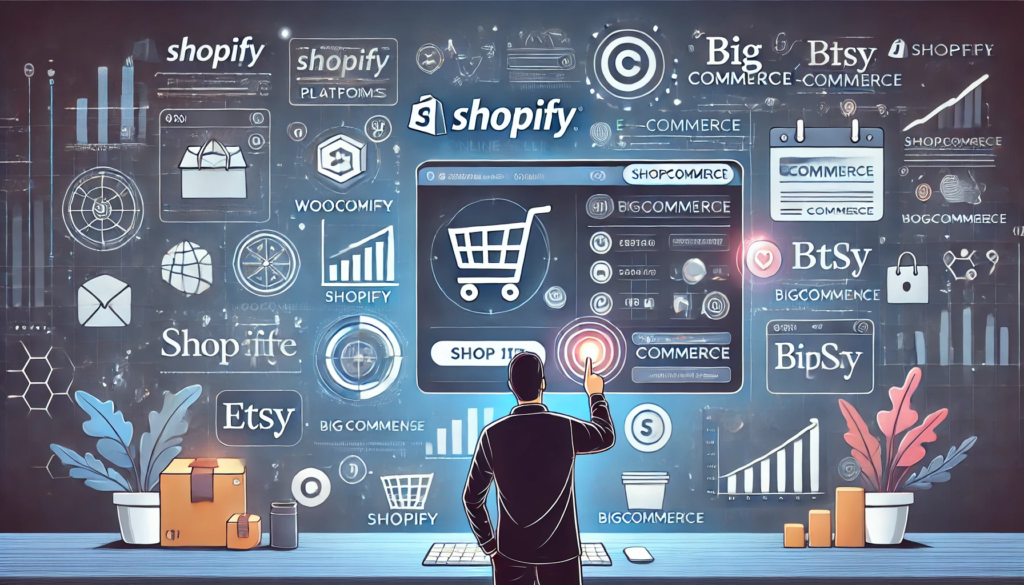Choosing the right e-commerce platform is one of the most critical decisions you’ll make when starting your online selling business. The platform you select will shape the entire shopping experience for your customers, impact your operational efficiency, and determine how easily you can scale your business. In 2025, the landscape of e-commerce platforms has expanded with many advanced options tailored to different types of sellers, from beginners to large enterprises.
In this comprehensive guide, we’ll explore the key factors to consider when choosing the best platform for your online store, compare popular platforms, and help you find the ideal fit for your business goals.
Why Choosing the Right Platform Matters
The right e-commerce platform can make or break your online business. A platform that aligns with your needs will allow you to:
- Efficiently manage products, payments, and shipping
- Provide a seamless, user-friendly experience for customers
- Scale your business as it grows
- Implement marketing strategies easily
Choosing the wrong platform, on the other hand, can lead to headaches, increased costs, and lost sales. Therefore, it’s crucial to take time in evaluating your options based on your business model, technical expertise, and long-term goals.
Key Considerations for Choosing the Right Platform
When deciding which e-commerce platform to use, consider the following key factors:
1. Ease of Use
If you’re new to e-commerce, ease of use should be a top priority. A platform with a user-friendly interface will save you time and frustration. Look for drag-and-drop builders, simple navigation menus, and platforms that require little to no coding knowledge.
Some platforms, like Shopify, are renowned for their beginner-friendly setup, while others, like WooCommerce, may require more technical expertise but offer greater customization.
2. Customization and Design Options
The design of your online store plays a significant role in how customers perceive your brand. A well-designed website with an attractive, intuitive layout will keep visitors on your site longer and encourage them to make purchases.
Consider whether you want complete control over your site’s design or prefer pre-made templates that can be customized to fit your brand. Platforms like WooCommerce and Magento offer endless customization options but may require some coding skills. In contrast, Squarespace and Shopify offer sleek, ready-to-use templates that are customizable without any coding knowledge.
3. Scalability
Your platform should grow with your business. While your online store may start small, it’s essential to choose a platform that can scale to meet your evolving needs, especially if you plan to expand your product offerings, increase traffic, or venture into international markets.
Platforms like BigCommerce and Shopify Plus are designed for scalability, making them suitable for businesses with high growth potential. These platforms can handle large product catalogs, heavy traffic, and advanced functionalities like multi-currency and multi-language support.
4. Payment Gateways and Transaction Fees
The ability to accept payments easily and securely is a core function of any e-commerce platform. Check whether the platform supports your preferred payment gateways (e.g., PayPal, Stripe, or even cryptocurrency). Additionally, pay attention to any transaction fees the platform might charge.
For instance, Shopify charges a transaction fee unless you use its own Shopify Payments gateway, while WooCommerce allows more flexibility by supporting a wide range of third-party payment processors with no additional transaction fees.
5. SEO and Marketing Features
To succeed in the competitive world of e-commerce, you’ll need a platform that supports search engine optimization (SEO) and marketing efforts. This includes built-in SEO tools, like customizable meta tags, SEO-friendly URLs, and sitemaps. It also includes support for advanced marketing strategies like email campaigns, abandoned cart recovery, and integrations with social media platforms.
BigCommerce is known for its strong SEO capabilities, while Shopify and WooCommerce also provide a range of SEO tools and apps to help improve your store’s search rankings.
6. Pricing and Budget
Your budget will play a significant role in the platform you choose. Be sure to factor in not only the initial setup cost but also monthly fees, transaction fees, and the cost of any additional apps or plugins you may need.
- Shopify offers a range of pricing plans starting at $29/month, with higher tiers offering more features.
- WooCommerce itself is free, but you will need to pay for hosting, plugins, and additional features, which can add up over time.
- Squarespace starts at around $16/month but has limited e-commerce functionality compared to other platforms.
7. Support and Resources
Look for a platform with reliable customer support, especially if you’re a beginner. Some platforms, like Shopify, offer 24/7 customer service via live chat, email, or phone. BigCommerce and Squarespace also offer robust support options.
If you prefer self-learning, make sure the platform has a comprehensive knowledge base, tutorials, and community forums to help you troubleshoot and grow your business.
Popular E-Commerce Platforms: A Comparison
Now that you know what to look for in a platform, let’s dive into some of the most popular e-commerce platforms available in 2025. Here’s a detailed comparison of their strengths, weaknesses, and who they’re best suited for:
1. Shopify
Best for: Beginners and growing businesses
Shopify is one of the most popular e-commerce platforms, and for good reason. It’s incredibly easy to use, making it ideal for beginners. Shopify offers a variety of professionally designed themes, customizable features, and a vast app marketplace for additional functionality.
- Pros:
- User-friendly interface
- 24/7 customer support
- Great for dropshipping and print-on-demand
- Scalable, with options for enterprise-level businesses (Shopify Plus)
- Cons:
- Transaction fees unless using Shopify Payments
- Limited customization without advanced coding
- Pricing: Starts at $29/month, with higher tiers for more features.
2. WooCommerce
Best for: WordPress users and those needing more customization
WooCommerce is an open-source plugin for WordPress, allowing you to transform your WordPress website into a fully functional e-commerce store. It’s highly customizable and ideal for businesses that need complete control over their online store.
- Pros:
- Highly customizable
- No transaction fees
- Wide range of plugins and extensions
- Control over hosting and design
- Cons:
- Requires more technical knowledge
- Hosting costs can add up
- Pricing: Free, but you’ll need to pay for hosting, security, and plugins.
3. BigCommerce
Best for: High-volume sellers and rapidly growing businesses
BigCommerce is a powerful, scalable platform designed for businesses looking to grow quickly. It offers a robust set of features, including multi-channel selling, advanced SEO tools, and no transaction fees.
- Pros:
- Built-in SEO and marketing tools
- No transaction fees
- Scalable with multi-channel selling options
- Strong inventory management
- Cons:
- Higher pricing compared to other platforms
- Limited themes and design options
- Pricing: Starts at $29.95/month, with enterprise plans available.
4. Squarespace
Best for: Creatives and small businesses
Squarespace is known for its stunning design templates, making it a popular choice for creatives and small businesses. While its e-commerce features are more limited than Shopify or WooCommerce, it’s a great choice for those looking for simplicity and style.
- Pros:
- Beautiful, responsive design templates
- Easy to use with built-in features
- Integrated with blogging tools
- Cons:
- Limited payment gateway options
- Fewer e-commerce features compared to other platforms
- Pricing: Starts at $16/month, with e-commerce plans from $26/month.
5. Etsy
Best for: Handmade or vintage products, and small-scale sellers
Etsy is a marketplace rather than a full-fledged e-commerce platform, but it’s an excellent option for individuals selling handmade or vintage goods. Etsy provides a ready-made audience and minimal setup, making it easy to get started.
- Pros:
- Built-in marketplace with millions of users
- Easy to set up
- Great for niche products like handmade crafts
- Cons:
- Transaction and listing fees
- Limited branding and design control
- Pricing: Listing fee of $0.20 per item, plus 5% transaction fee.
Conclusion
Choosing the right platform for online selling in 2025 requires careful consideration of your business goals, technical expertise, and budget. Platforms like Shopify and BigCommerce offer scalability for businesses looking to grow, while WooCommerce provides customization for those with technical know-how. Squarespace is ideal for creatives, and Etsy serves as an easy entry point for sellers of handmade goods.
Evaluate the strengths and weaknesses of each platform, think about where you want your business to be in the future, and select the one that best aligns with your needs. The right platform will provide a solid foundation for building and growing a successful online store.
Frequently Asked Questions (FAQ)
1. What is the easiest platform for beginners to use?
Shopify is widely considered the easiest platform for beginners due to its user-friendly interface, drag-and-drop website builder, and 24/7 customer support. It requires no coding knowledge, making it ideal for first-time sellers.
2. Which platform is best for customization?
WooCommerce offers the best customization options, especially if you have a WordPress website. It’s highly flexible and allows for deep customization through plugins, themes, and coding.
3. Can I switch platforms later if my business grows?
Yes, it’s possible to switch platforms, but it can be a complex process involving data migration, design changes, and potential downtime. It’s best to choose a scalable platform from the start to avoid this hassle.
4. What platform should I choose if I’m selling digital products?
Platforms like Shopify, WooCommerce, and BigCommerce all support digital product sales, but WooCommerce might be the best choice if you need more control over how your digital products are delivered.
5. Are there any free e-commerce platforms?
Yes, WooCommerce is free to use as a WordPress plugin, but you’ll need to pay for hosting, security, and additional plugins. Other platforms, like Shopify and BigCommerce, offer free trials but have monthly fees.
6. What’s the best platform for selling internationally?
BigCommerce and Shopify are excellent choices for international selling. They offer multi-currency support, multilingual functionality, and international shipping integrations.

